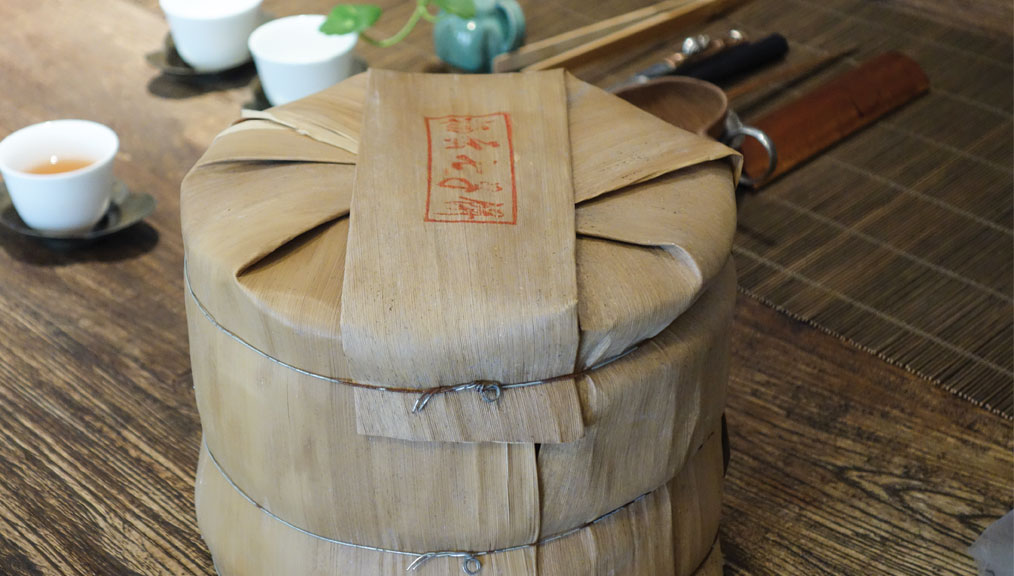Photos: Zian Chan Tea, D.B.A. Teabook.
In this article:
- Pu-erh is cultivated from several types of trees, including plantations trees, ancient trees, and sustainable trees.
- Fermentation period plays a significant role in distinguishing the flavor of pu-erh. Some teas are aged more than twenty years.
- How to assess cake, liquor, and taste in order to select a high-quality pu-erh in the marketplace.
- Five tricks to brewing the perfect cup of pu-erh (hint: don’t use boiling water!).
Ancient Roots
In remote, mist-shrouded villages in southern Yunnan, leaves of the Camellia sinensis var. assamica are harvested by hand, using techniques passed down for generations. In this southwestern Chinese province, the land is embellished by winding ravines and densely forested mountains; it’s here these broad-leaved tea trees have grown in their native environment for thousands of years. Through careful processing, leaves full of the vitality of the very mountains they grew on are transformed into pu-erh tea.
Pu-erh tea has been well-documented for many hundreds of years in classical Chinese literature, sought after for its magnificent complexity of flavors and purported medicinal benefits. Writings throughout China’s history describe health properties ranging anywhere from a digestive aid to a component in the fabled “Elixir of Immortality.”
Pu-erh tea is learned through experience and patience. Grown all over Yunnan on a dozen different mountains on thousands of farms, processed in hundreds of different ways, and stored in various conditions anywhere in the world, pu-erh presents an array of tastes and aromas in each cup.
Chinese tea masters may dedicate a lifetime to cultivating a perfect tea cake. But this pursuit is highly subject to personal preference—with so many variables involved and so many different palates to please, there cannot exist a best pu-erh. But the intricacy of pu-erh makes it an exciting and intriguing tea—both as the subject of personal study, and as a unique item to add to your shop’s menu. Understanding where pu-erh comes from, how it’s processed, and how to develop your palate for the diversity of flavors it offers will help you share this unique tea with your customers, and encourage continued study to grow your understanding of this complex tea.
Cultivation
Yunnan is known for being the birthplace of tea, as well as the home of pu-erh. The southern area of the province houses four major pu-erh producing regions: XishuangBanna, Simao, Baoshan, and Lincang. Teas from XishuangBanna and Simao usually draw a higher price due to the age of trees in these regions and the beverage’s delicate taste. Baoshan is marked by large plantations of sustainable tea trees that yield a stronger tasting drink. Pu-erh from Lincang is known for a stronger taste and has become popular with merchants in Hong Kong.
Notable differences in pu-erh’s flavor derive from the cultivation method—the type of tree the leaves were grown on. These methods include the aforementioned ancient and plantation tree teas, as well as sustainable tree tea, or shengtai cha. Other methods include wild tree tea, big tree tea, and mother tree tea.
Plantation tea, or taidi cha, is the most common type of pu-erh tea in our current market. High volumes of tea bushes and plants grow in very dense rolls, usually on small mountains or hillsides (these trees are commonly seen without any trunk or branches). Plantation trees are mostly propagated from cuttings of original bushes or gushu tea trees, so the resulting teas display very similar genetic makeups and traits. These bushes are kept tightly trimmed for easy harvesting and picking. Because of the density and unnatural formation of these bushes, pesticides and chemical fertilizers are more common in plantation tea. Taidi has grown popular among farmers because the annual yield is very high and can meet demands of international mass production.
Ancient tree tea, or gusha cha, is the oldest form of pu-erh tea cultivation. The oldest living pu-erh tree is 3,200 years old and resides in Feng Qing, Yunnan. Gardens of ancient trees appear almost as natural forests, grown at higher elevations of mountain ranges, developed from seeds planted hundreds and thousands of years ago alongside many other indigenous trees and plants. Their ability to adapt to the ever-changing environment has supported the development of genetic diversity over generations, yielding a tree that’s self-sustaining and requires little to no human intervention, with no need for chemicals or pesticides. These trees grow symbiotically with other varieties of plants and possess a very unique mineral and nutritional content, and a diverse flavor profile. This diversity is pronounced in raw pu-erh through a noticeable terroir profile that varies from mountain to mountain.
Fermentation
In addition to regional terroir and tree type, pu-erh is also distinguished by length of fermentation. Because of the unique qualities of these leaves, pu-erh does not lose its flavor with time like other teas. Instead, like wine, the tea’s taste and aroma develop with each year stored, becoming smoother, more flavorful, and more defined.
Raw Pu-erh
The most ancient form of pu-erh tea is raw, or sheng, pu-erh. Once its leaves are picked from trees, material from various mountain ranges are blended together, or left as a single-state blend. The blended leaves are left to wilt in the sun, then oxidized to the stage of a green tea. Then, after being steamed (just enough to loosen the leaves to press into cakes, not to be confused with the steaming process of Japanese green teas) and pressed into cakes, the cake undergoes a fermentation process catalyzed by enzymes found within the tea leaves. During this fermentation period, sometimes taking upwards of twenty years to complete, the unique notes associated with raw pu-erh bloom and evolve.
Raw pu-erh is characterized by anything from astringent, woodsy, nutty, or floral pungency for young cakes (affected by the mountain range where it’s grown) to a smooth, smoky, or sweet savor in aged cakes. Aged cakes can also contain vegetal, fruity, camphor, jujubee, dragon eye (longan fruit), or earthy notes.
Aged Raw Pu-erh
As raw pu-erh ages, it begins to develop unique characteristics in taste, aroma, and body. A raw pu-erh might be considered aged after ten years, or twenty, or even longer. No set aging time defines a pu-erh as raw or aged raw, due to the number of variables that contribute to the development of each individual tea. A loose leaf tea will naturally age faster, and the humidity of the aging environment dramatically affects the progression. Dry storage tends to preserve the sweet wood and floral characteristics of the tea, where wetter storage yields strong fermentation and mushroom-like taste. Often sought for its medicinal effects, this tea is much less aggressive than younger, raw pu-erh.
Ripe Pu-erh
Ripe pu-erh was developed in the 1970s as a way to artificially accelerate the fermentation process. After the leaf is dried and rolled, it’s subjected to a high-humidity wet-piling process in a controlled factory setting. During this period, moisture is added to the tea (similar to a compost pile), allowing it to ferment quickly and predictably. While this production method was originally developed to mimic the qualities of aged raw pu-erh in less time, ripe pu-erh has taken on an identity of its own, and is sought after by collectors and casual drinkers alike for its earthy, mellow flavors, and sweet lingering aftertaste.
Ripe pu-erh lends itself to only a handful of flavor profiles and its liquid is a dark and thick. Aged raw pu-erh yields hundreds of different flavor profiles; the complexities of the aging process draw out subtle flavors that are missed in the accelerated ripening process.
Selection
As a friend and business owner recently conveyed to me in an email, the pu-erh market is a “buyer-beware market,” meaning that consumers must be tea-educated to effectively sift through the jumbled mess that is the pu-erh market. It takes time to develop this knowledge, but keeping the basics in mind will help guide you to selecting a high-quality pu-erh.
What to look for when sourcing pu-erh:
CAKE: A uniform color and consistent leaves throughout the whole cake, with no dust, and no small yellow or white particles.
LIQUOR: From a light amber to a deep golden hue with little to no cloudiness, especially in older teas. (There should be no oily film or off color on the surface of liquor, this can be an indication of pesticide usage.)
TASTE: Clean, soft, and round; a complex flavor, leaving the throat and mouth with a subtle sweetness and a slight dryness.
A Note on Picking Pu-erh
Historically pu-erh tea was picked twice a year, once in spring and once in autumn, allowing enough time for a new batch of leaves to grow and be rich in mineral content. If a tea tree is plucked too frequently in the year, it will be less durable or yield fewer steepings. Continued over-picking causes the tea tree to become strained and overworked, producing a less durable tea leaf during brewing. This problem became more noticeable around 2006 when pu-erh tea reached a market peak, and some farmers picked leaves year round.
Suggestions for Brewing
As with most teas, pu-erh is best brewed using a traditional method, whether using a gaiwan, or a yixing, ceramic, or porcelain teapot.
A few tricks that work for me:
1. When breaking off leaves from the cake, try to keep the leaves intact. If the leaves are broken, the flavor flows out from the broken pieces too quickly, resulting in murky or astringent tea.
2. Do not use boiling water, as this will scald the tea leaves. A high-quality pu-erh, either ripe or raw, may handle water up to ten degrees under boiling. Remember, you can always increase the heat of the water, but if you burn it on the first steep, your tea won’t release the depth and complexity of all its flavors correctly.
3. Make sure your water is clean—avoid unfiltered tap water at all costs. Tap water contains minerals as well as fluoride, which mingle with the flavors of the tea and mask the beautiful subtleties of pu-erh. As avid tea drinkers know, this advice extends into all other varieties of tea.
4. Try shorter steeping times at first, then work up to gradually steeping longer and stronger as you brew. This allows the multitude of its flavors to evolve slowly, rather than all at once.
5. Keep practicing. The first time I made pu-erh on my own it was absolutely terrible. Not only does it take dozens of steeps to learn the best way to extract the beauty of pu-erh, but each pu-erh is unique in and of itself. Let the tea speak to you, for each individual cake has its own ideal brew method.
For Americans, I feel like the art of making tea is at odds with our cultural expectations. When we make tea, we have a preconception about how it should taste, or how we want it to taste, and we try to force it to fit that ideal. However, every tea is different, and even the same tea can change on different days depending on humidity or temperature. It is best to view “making” tea more as a process of allowing the tea to release its own potential. This way it is a symbiotic relationship between tea maker and tea. We listen, in a sense, to what the tea is saying, and we make it accordingly.
It takes a patient, attentive listener, but it’s well worth it to listen.
—Jeffrey McIntosh is the owner of Teabook.



















